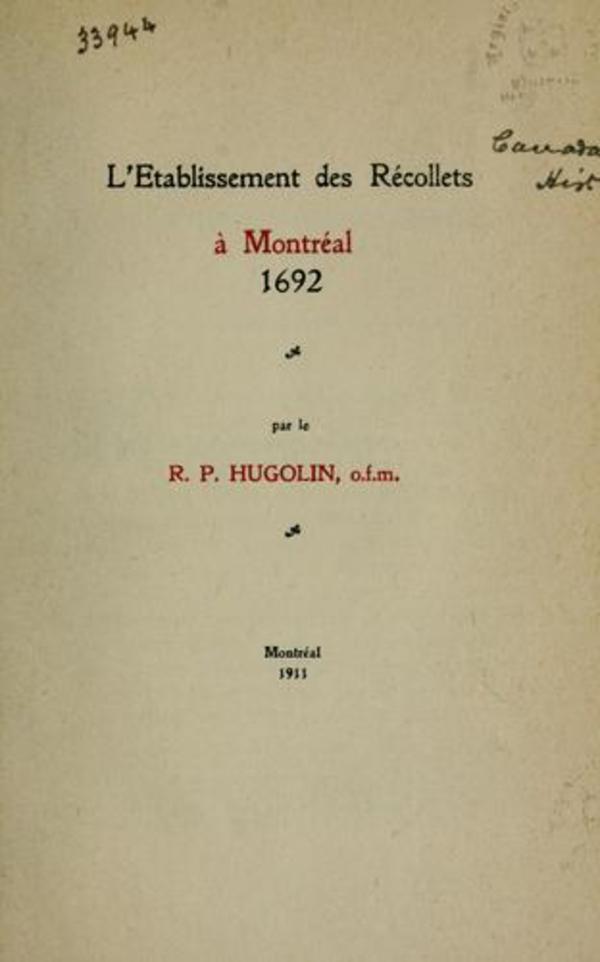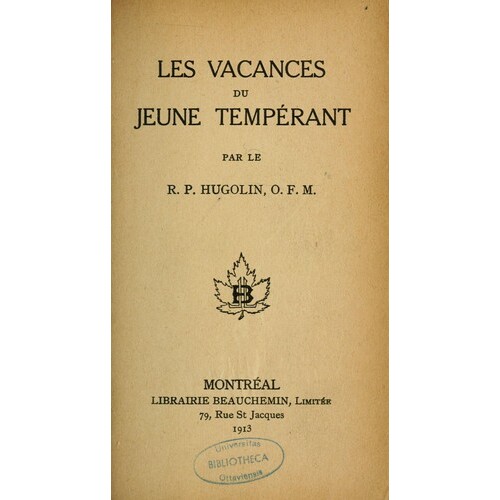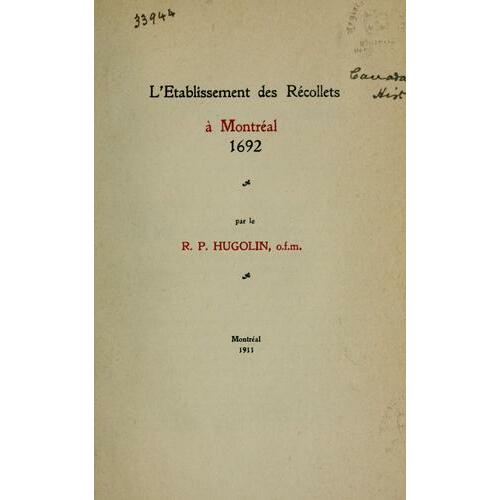
Source: Link
LEMAY, HUGOLIN (baptized Stanislas) (on entering the priesthood, he took the name Hugolin-Marie; he mostly signed Père Hugolin but sometimes Père Hugolin Lemay), Franciscan, preacher, author, bibliographer, and librarian; b. 20 Sept. 1877 in the parish of Saint-Édouard at Knowlton (Lac-Brome), Que., son of Bernard Lemay, a furniture maker, and Marylise Turcotte; d. 25 June 1938 in Montreal.
Stanislas Lemay was the eldest of six children. While he was still young, his family moved to Coaticook, where around 1890 he began his secondary education at the Académie du Sacré-Cœur. In 1893, after a year of private lessons under the direction of his parish priest, he entered the Séminaire de Saint-Hyacinthe, a leading centre for Franciscan training, to pursue his classical studies. It was while he was there that Lemay discovered his passion for writing and his interest in journalism. He contributed articles to several periodicals, including La Vérité of Quebec City. In the summer of 1897 he was asked to work there as an intern by its editor, founder, and owner, the ultramontane intellectual Jules-Paul Tardivel*. Moreover, he did not hesitate to champion Tardivel’s ideas and to stir up controversies through pieces written in the passionate style for which he would become famous. After wavering between journalism and the priesthood, he finally entered the Franciscan order on 19 Aug. 1898. He took the name Hugolin-Marie and was ordained a priest on 25 July 1903 in Montreal.
In December 1905, Archbishop Paul Bruchési of Montreal launched a major temperance campaign and entrusted the Franciscans, who were known for the quality of their preachers, with the task of running it. Hugolin, whose incisive pen, oratorical skills, and fiery temperament had already attracted notice, was chosen to be a member of the triumvirate (probably with Father Ladislas Minette and Father Joachim-Joseph Monfette) that was to lead the campaign. He quickly distinguished himself by his zeal, looking after wide circulation of the many writings on temperance that he produced in diverse forms. They included brochures (Si femme savait! Si femme voulait! Femme contre intempérance, which came out in Montreal in 1907, with a print run of 40,000), tracts, plays (Les manifestes électoraux, issued in Montreal in 1909), articles in newspaper and journals (for example, he wrote 32 for L’Action sociale between 1908 and 1910). He was also the author of a volume entitled Bibliographie des ouvrages concernant la tempérance … imprimés à Québec et à Lévis depuis l’établissement de l’imprimerie [1764] jusqu’à 1910, which was published at Quebec in 1911 but previously released in instalments in the Bulletin des recherches historiques of Lévis between July 1910 and August 1911. In addition Hugolin was made editor of the journal La Tempérance, the official organ of the campaign, which had been set up in Montreal. During his tenure its circulation ranged from 22,000 to at least 39,000. He held this post from 1911 to 1912 and again from 1916 to 1918.
In 1912–13 Hugolin fell severely ill with tuberculosis, an experience deeply affecting him that he wrote about in De la mort à la vie, a small book published in Montreal in 1916. Forced to take a prolonged rest-cure and redirect his career, he turned his attention to bibliography, a field whose methodology he had taught himself in the course of his research during the temperance campaign. Although his ultimate plan was to compile a general inventory of Canadian printed works, his many bibliographies are concerned primarily with the activities of the Franciscans in Canada. Thus his major work, which appeared at Quebec in 1916 and then in enlarged editions in 1932 and 1936, is the Bibliographie franciscaine: inventaire des revues, livres, brochures et autres écrits publiés par les franciscains du Canada de 1890 à 1915. His publications include collections of previously printed articles (such as Horizons et pensées, which came out in Montreal in 1925), historical and bibliographical studies on the Recollet apostolate in New France, and bio-bibliographies of leading Canadian Franciscans.
The high quality of Hugolin’s work earned him election to the Royal Society of Canada in 1928. His excellence also led to his being sent in 1933 to St Bonaventure College in Quaracchi (part of Florence, Italy) as a collaborator in an enormous project: the assembling of a bibliography of Franciscan scholarship since the founding of the order. This college was an important centre of Franciscan research in the fields of philosophy, theology, history, and philology. During his stay in Europe, Hugolin also carried out research, in various archives, on Father Louis Hennepin*, a Recollet who was famous for, among other things, his controversial accounts of his travels in Louisiana. He pursued his studies when he returned to Canada in 1936; the following year the results were made public in a book, Bibliographie du père Louis Hennepin, récollet: les pièces documentaires (Montréal), in which he attempted to rehabilitate Hennepin’s reputation.
In 1936, thanks to the expertise he had acquired over the years, Hugolin was appointed provincial librarian of the Franciscan order in Canada. In this capacity, he replaced the Dewey decimal classification with an alphabetical system better suited to the particular needs of the order’s libraries, whence his Tableau de classification pour les bibliothèques des Frères mineurs du Canada, published in Montreal in 1937. That year Ægidius Fauteux* invited him to join the faculty of the new École des Bibliothécaires, which was affiliated to the Université de Montréal, an offer he accepted with enthusiasm. According to Franciscan Onésime Lamontagne, a former student of the library school, Hugolin “left the impression there of a rare competence coupled with an exuberant and brilliant spontaneity.” Father Hugolin died suddenly on 25 June 1938, at the age of 60, scarcely two days after his last visit to the Bibliothèque de la Ville de Montréal.
Georges Robitaille, who wrote a biography of Hugolin Lemay for the Royal Society of Canada shortly after his death, stressed that he was a man who “disliked coteries and little cliques” and who hid the love he felt for his brothers in religion “beneath a rough, sometimes violent exterior.” In the opinion of Marie-Claire Daveluy*, a professor at the École des Bibliothécaires, as reported by Father Odoric Bouffard, his vehemence did not, however, rob him of a “sense of humour and of the colourful that made Father Hugolin Lemay – bibliophile, bibliographer, and librarian – an original, agreeable character.”
Hugolin Lemay left an impressive scholarly heritage. Even in 1932, the list of his publications comprised 70 books and brochures, and more than 260 periodical articles. This bibliography bears witness to the two principal areas of his legacy. On the one hand, he is remembered as the preacher who fulminated against alcoholism and its ill effects. As Omer Héroux* emphasized in an editorial in Le Devoir on 27 June 1938: “For the general public of twenty-five or even thirty years ago, Father Hugolin was the great apostle of temperance.… And it is for this, clearly, that his name will live on with ordinary people.” On the other hand, the intellectual will be remembered as a pioneer in the fields of library science and bibliography in Quebec.
Arch. des Franciscains (Montréal), B31.1 (dossier du personnel), 52 (Hugolin Lemay), post mortem; 17Q (fonds Hugolin Lemay); Reg. 1K (sépultures), 35. BANQ-E, CE502-S13, 22 sept. 1877. Le Devoir, 27–28 juin 1938. La Presse, 27 juin 1938. Odoric Bouffard, “Lemay, père Hugolin-M.,” in C’était mon frère ... soixante-quinze ans de vie franciscaine au Canada, 1890–1965, Bertrand Saint-Pierre et Léandre Poirier, édit. (Montréal, 1965), 274–75. DOLQ, 2: 91, 656–57, 749–50. Encyclopedia Canadiana, ed. K. H. Pearson et al. ([rev. ed.], 10v., Toronto, 1975). Père Hugolin [Stanislas Lemay], Bibliographie du R. P. Hugolin, o.f.m., de la Société royale du Canada (Montréal, 1932). Onésime Lamontagne, “L’ami des livres,” in Ils étaient des nôtres ([Trois-Rivières, Québec], 1953), 19–27. Léandre Poirier et Jean Hamelin, “Hugolin Lemay et Conrad Morin, pionniers en histoire et en bibliographie,” in Les franciscains au Canada, 1890–1990, sous la dir. de Jean Hamelin (Sillery [Québec], 1990), 285–94. Georges Robitaille, “Le père Hugolin Lemay (1877–1938),” RSC, Trans., 3rd ser., 33 (1939), proc.: 135–38. Wallace, Macmillan dict.
Cite This Article
Maxime Forcier, “LEMAY, HUGOLIN (baptized Stanislas) (Hugolin-Marie, Père Hugolin, Père Hugolin Lemay),” in Dictionary of Canadian Biography, vol. 16, University of Toronto/Université Laval, 2003–, accessed December 18, 2025, https://www.biographi.ca/en/bio/lemay_hugolin_16E.html.
The citation above shows the format for footnotes and endnotes according to the Chicago manual of style (16th edition). Information to be used in other citation formats:
| Permalink: | https://www.biographi.ca/en/bio/lemay_hugolin_16E.html |
| Author of Article: | Maxime Forcier |
| Title of Article: | LEMAY, HUGOLIN (baptized Stanislas) (Hugolin-Marie, Père Hugolin, Père Hugolin Lemay) |
| Publication Name: | Dictionary of Canadian Biography, vol. 16 |
| Publisher: | University of Toronto/Université Laval |
| Year of publication: | 2014 |
| Year of revision: | 2014 |
| Access Date: | December 18, 2025 |




